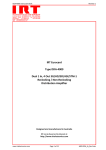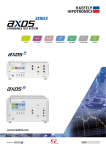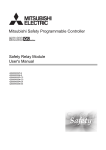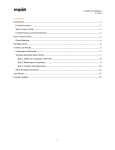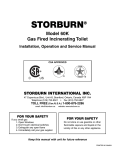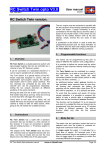Download IRT-6080-DVS User Manual (Revision 00)
Transcript
IRT-6080-DVS 3G/HD/SD-SDI / ASI Digital Video Switcher & Router User Manual IRT Electronics Pty Ltd | www.irtelectronics.com Page 1 of 29 Revision 00 IRT-6080-DVS 3G/HD/SD-SDI / ASI Digital Video Switcher Revision History: Revision 00 Date 26/09/2013 By AL Change Description Original Issue. Applicable to: Firmware ≥ Revision 3.0 IRT Electronics Pty Ltd | www.irtelectronics.com Page 2 of 29 Revision 00 IRT-6080-DVS USER MANUAL Table of Contents: Section Page Revision History Operational Safety openGear® Introduction General Description Technical Specifications Configuration DIP Switch Settings 8x1 Switcher Quick Set-up Guide 8x2 Router Quick Set-up Guide Dual 4x1 Switcher Quick Set-up Guide 4x2 Router Quick Set-up Guide Installation Signal Inputs & Outputs Remote Rear Assembly Wiring HE-14 Connector Pin Assignments 15-pin D-Connector Pin Assignments 9-pin RS-232 D-Connector Pin Assignments Front Edge LED and Switches Location Rear Assembly Layouts Operation Single 8x1 Mode 8x2 Router Mode Dual 4x1 Mode 4x2 Router Mode Remote Control IRT-RC1 IRT-RC2 IRT-RP1 DashBoard™ Software Control IRT-6080-DVS DashBoard™ Screenshots Maintenance & Storage Warranty & Service 2 4 4 5 6 7 7 9 10 11 12 13 13 13 14 14 14 15 16 17 17 17 18 18 19 19 20 20 21 21 29 29 This instruction book applies to units fitted with firmware ≥ Revision 3.0. IRT Electronics Pty Ltd | www.irtelectronics.com Page 3 of 29 Revision 00 IRT-6080-DVS OPERATIONAL SAFETY WARNING Operation of electronic equipment involves the use of voltages and currents that may be dangerous to human life. Note that under certain conditions dangerous potentials may exist in some circuits when power controls are in the OFF position. Maintenance personnel should observe all safety regulations. Do not make any adjustments inside equipment with power ON unless proper precautions are observed. All internal adjustments should only be made by suitably qualified personnel. All operational adjustments are available externally without the need for removing covers or use of extender cards. openGear® INTRODUCTION Developed by Ross Video, openGear® is a standard where various manufacturers can design their equipment to fit a common frame allowing the end user to mix and match the various openGear® cards available in the market place together in one frame. This allows a single frame to be used instead of multiple different vendor’s frames that each would otherwise be using their own proprietary standard. A simple to use monitoring and control software called DashBoard™ is a free program downloadable from the openGear® website (www.opengear.tv) that allows the user to remotely monitor and control an openGear® type card fitted within an openGear® frame that meets the openGear® standard for DashBoard™ control. A link is also supplied via the IRT Electronics website (www.irtelectronics.com) under the openGear® navigation section. IRT Electronics’ openGear® cards are designed to meet the openGear® standard for mounting within the openGear® OG3-FR frame and its earlier version DFR-8300 frame, and is fully compliant with DashBoard™ control. The openGear® frame manual, DashBoard™ control software and information regarding the frame’s power supplies, controller card and frame accessories are available for download at the openGear® website. The term openGear® is a registered trade mark of Ross Video Limited. DashBoard software Control™ is a trade mark of Ross Video Limited. IRT Electronics Pty Ltd | www.irtelectronics.com Page 4 of 29 Revision 00 IRT-6080-DVS GENERAL DESCRIPTION The IRT-6080-DVS digital video switcher is part of a family of “smart” switchers in openGear® format that may be configured by the user to cover a wide range of switching and monitoring functions. On board configuration is possible to allow the IRT-6080-DVS to be used as an 8x1 switcher with 2 common outputs; a dual independent 4x1 switcher; an 8x2 or 4x2 router. Push-button switches along the front edge provide local control, although control is usually intended via a software interface such as DashBoard™. Optionally remote control is via a momentary wire per crosspoint (WPX) control connector allowing interface to a remote control panel or a telemetry system, or alternatively an RS232 remote control is also available providing extended control. Front edge switches can be disabled for tally indication only so as to prevent accidental switching when intending only to use one of the remote control options. The IRT-6080-DVS is designed to fit the openGear® standard 2RU frames which allow a mixture of cards from various manufacturers to be mounted within the same frame. The DashBoard™ control software is available as a free download. Standard features: • 3G-SDI, HD-SDI, SD-SDI or ASI capable. • 8x1 or dual 4x1 switching operation. • 8x2 or 4x2 router setup. • Automatic muting on loss of inputs. • Front edge local control with remote control option. • DashBoard™ software monitoring and control. IRT Electronics Pty Ltd | www.irtelectronics.com Page 5 of 29 Revision 00 IRT-6080-DVS TECHNICAL SPECIFICATIONS Signal inputs: Number Type Automatic cable compensation Impedance 8. 3G-SDI, HD-SDI, SD-SDI or ASI. > 100 m at 2.97 Gb/s (3G-SDI) with Belden 1694A; > 100 m at 1.485 Gb/s (HD-SDI) with Belden 1694A; > 250 m at 270 Mb/s (SD-SDI/ASI) with Belden 8281. 75 Ω. Signal outputs: Type 2 x 800 mV ±10% into 75 Ω. Control: Type 1 Momentary wire per crosspoint (WPX) grounding contacts (Front edge push button switches or optional IRT-RC1 remote control panel). Type 2 openGear® DashBoard™ software. Type 3 RS-232 (9600bps, 8 data bits, No parity, 1 Stop bit, No flow control) (optional IRT-RC2 remote control panel). Performance: Return loss DC offset Output rise and fall time Intrinsic jitter > 15 dB 5 MHz to 1.5 GHz; > 10 dB 1.5 GHz to 2.97 GHz. 0 V ±0.5 V. < 135 ps at 2.97 Gb/s and 1.485 Gb/s; 0.4 ns and < 1.5 ns at 270 Mb/s. < 0.3 UI at 2.97 Gb/s reclocked; < 0.2 UI at 1.485 Gb/s reclocked; < 0.1 UI at 270 Mb/s reclocked. Power Requirements: Voltage Power consumption + 12 Vdc. < 5VA. Connectors: 3G/HD/SD-SDI / ASI Control (with remote option) BNC. Plug in 10 pin HE14 dual IDC, DB9 or DB15. Other: Temperature range 0 - 50° C ambient. Mechanical Suitable for mounting in an openGear® 2RU rack chassis. Dimensions (openGear® standard) 33.6 mm x 2U x 325 mm; (67.3 mm x 2U x 325 mm with remote option rear assembly). Supplied accessories Rear connector assembly. Optional accessories IRT-RC1 remote control panel with 8 pushbuttons & tally LED’s. IRT-RC2 RS-232 remote control panel with 2 x 8 (16) pushbuttons & tally LED’s. Ordering Standard, programmed with DashBoard™ control. Remote control panel with 8 pushbuttons & tally LED’s. RS-232 remote control panel with 2 x 8 (16) pushbuttons & tally LED’s. Double width rear assembly for IRT-RC1 and IRT-RC2 remote control panels. 1RU 19” rack mounting plate for IRT-RC1 and IRT-RC2 remote control panels. IRT-6080-DVS IRT-RC1 IRT-RC2 IRT-6080-ZRC IRT-RP1 Due to our policy of continuing development, these specifications are subject to change without notice. IRT Electronics Pty Ltd | www.irtelectronics.com Page 6 of 29 Revision 00 IRT-6080-DVS CONFIGURATION The IRT-6080 is an 8 input, 2 output device that may be configured via on board DIP switches as a single 8x1 switcher, where both outputs are the same; an 8x2 router, where both outputs are independent from each other (required to be used in conjunction with a remote panel or via Dashboard™ control); a 4x2 router, where outputs are independent from each other and inputs 1A - 4A (1 - 4) are internally connected to inputs 1B - 4B (5 - 8). DIP Switch settings: ON DIP ON 1 2 3 4 5 6 7 8 DIP 1 2 3 4 5 6 7 8 SW11 SW10 Output Signal Rate Set (8x1 and ‘A’ Output of 8x2 & dual 4x1 & 4x2 modes) 1 Auto Detect 2 SD-SDI / ASI only 2 HD-SDI only 2 3G-SDI only SW10-1 SW10-2 OFF ON OFF ON OFF OFF ON ON SW10-3 = OFF 8-input mode. = ON 4-input mode. SW10-4 = OFF 8x1 mode. In 8-input mode, remote panel mirrors local front edge switches (O/P A = O/P B). = ON 8x2 router mode (O/P A independent from O/P B). = N/A Not Applicable to 4-input mode (i.e. if SW10-3 = ON). 3 SW10-5 = OFF Factory use only – leave OFF. SW10-6 = OFF Enable front edge and remote panel switches (for 8x1 mode and O/P A switches of 8x2 and dual 4x1 & 4x2 modes). = ON Disable front edge and remote panel switches – Tally indication only. Control only possible via Dashboard™ control (for 8x1 mode and O/P A switches of 8x2 and dual 4x1 & 4x2 modes). SW10-7 = Not Used. SW10-8 = Not Used. ‘B’ Output Signal Rate Set (8x2, dual 4x1 & 4x2 modes only) 1 Auto Detect 2 SD-SDI / ASI only 2 HD-SDI only 2 3G-SDI only SW11-1 SW11-2 OFF ON OFF ON OFF OFF ON ON 3 SW11-3 = OFF Reclocker mode. In ‘Auto Detect’ mode, the outputs are muted if a selected input is not at the 3G/HD/SD/ASI rate. = ON Bypass Reclocker. In ‘Auto Detect’ mode, reclocker is bypassed on non 3G/HD/SD/ASI rates and passes input to outputs. SW11-4 = OFF Dual 4x1 mode. In 4-input mode, switcher behaves as two independent 4x1 switchers. (‘A’ Inputs → O/P A; ‘B’ Inputs → O/P B). = ON 4x2 router mode. In 4-input mode, ‘B’ inputs mirror ‘A’ inputs. (‘A’ Inputs → O/P A & independently to O/P B). NOTE: Actual physical inputs 1B (5), 2B (6), 3B (7) & 4B (8) are disabled. = N/A Not Applicable to 8-input mode (i.e. if SW10-3 = OFF). IRT Electronics Pty Ltd | www.irtelectronics.com Page 7 of 29 Revision 00 IRT-6080-DVS 3 SW11-5 = Factory use only – leave OFF. SW11-6 = OFF Enable front edge and remote panel switches (for O/P B switches of 8x2, dual 4x1 & 4x2 modes only). = ON Disable front edge and remote panel switches – Tally indication only (for O/P B switches of 8x2, dual 4x1 & 4x2 modes only). = N/A Not Applicable for 8x1 mode of operation. SW11-7 = Not Used. 4 SW11-8 = OFF Front edge and remote panel switches switch immediately when pressed. = ON Front edge and remote panel switches must be held for approximately 2 seconds before change in switcher state occurs. = N/A Not Applicable for front and remote panel switches when these have been disabled for Tally indication only. NOTE: 1 ‘Auto Detect’ mode will allow 3G-SDI, HD-SDI and SD-SDI (or ASI) signals to pass to the output even if inputs are of mixed types. DIP switch SW11-3 gives the option of either muting both outputs if a selected input is at a rate other than the 3G/HD/SD-SDI rates, or the internal reclocker is bypassed and the signal will still pass through, though the output level is still 800mV regardless of the other rate’s standard. 2 3G-SDI only, HD-SDI only and SD-SDI only settings will only pass an input if it is at the correct set rate, else the output will be muted if a chosen input does not match the set rate. 3 Leave SW10-5 and SW11-5 OFF – Reserved for Factory use only. 4 In order to prevent accidental switching via the front edge or remote panel switches, switches must be held in the pressed state for approximately 2 seconds before switching will occur. IRT Electronics Pty Ltd | www.irtelectronics.com Page 8 of 29 Revision 00 IRT-6080-DVS 8x1 Switcher Quick Set-up Guide: Outputs A and B are the same. What is switched to O/P A will also switch to O/P B. IRT-6080-DVS I/P 1 (8x1) O/P A O/P A = O/P B O/P B I/P 8 IRT-RC1 (Remote Panel) DashBoard® Control User’s Choice: SW10-1 = Rate Set in conjunction with SW10-2. See page 7. (SW10-1 = OFF + SW10-2 = OFF: SW10-2 = Rate Set in conjunction with SW10-1. See page 7. Auto Detect) SW10-3 = OFF 8-input mode. SW10-4 = OFF 8x1 mode (O/P A = O/P B). SW10-5 = OFF Factory use only – leave OFF. User’s Choice: SW10-6 = OFF Enable front edge and remote panel switches. = ON Disable front edge and remote panel switches – Tally indication only. SW10-7 = Not Used. SW10-8 = Not Used. SW11-1 = N/A Not Applicable. SW11-2 = N/A Not Applicable. User’s Choice: SW11-3 = OFF Reclocker mode. In ‘Auto Detect’ mode, the outputs are muted if a selected input is not at the 3G/HD/SD/ASI rate. = ON Bypass reclocker. In ‘Auto Detect’ mode, reclocker is bypassed on non 3G/HD/SD/ASI rates and passes input to outputs. = N/A Not Applicable for 3G-SDI only, HD-SDI only and SD-SDI / ASI only fixed rate modes. SW11-4 = N/A Not Applicable. SW11-5 = N/A Not Applicable. SW11-6 = N/A Not Applicable. SW11-7 = Not Used. User’s Choice: SW11-8 = OFF Front edge and remote panel switches switch immediately when pressed. = ON Front edge and remote switches must be held for approximately 2 seconds before change in switcher state occurs. = N/A Not Applicable if front edge and remote panel switches have been disabled for Tally indication only. IRT Electronics Pty Ltd | www.irtelectronics.com Page 9 of 29 Revision 00 IRT-6080-DVS 8x2 Router Quick Set-up Guide: Outputs A and B are independent from each other. For push-button switch control, the IRT-6080-DVS must be used in conjunction with the optional 2 x 8 button IRTRC2 remote control panel. Note that the IRT-6080-DVS’s own front edge push-buttons will only control O/P A. Without the optional remote control panel full 8x2 router operation is still possible via the DashBoard™ software control. IRT-6080-DVS I/P 1 (8x2) O/P A (Local & Remote Switch A Control) O/P B (Remote Switch B Control) I/P 8 O/P A independent from O/P B IRT-RC2 (Remote Panel) DashBoard® Control User’s Choice: SW10-1 = O/P A Rate Set in conjunction with SW10-2. See page 7. (SW10-1 = OFF + SW10-2 = OFF: SW10-2 = O/P A Rate Set in conjunction with SW10-1. See page 7. Auto Detect) SW10-3 = OFF 8-input mode. SW10-4 = ON 8x2 router mode (O/P A independent from O/P B). SW10-5 = OFF Factory use only – leave OFF. User’s Choice: SW10-6 = OFF Enable O/P A front edge and O/P A remote panel switches. = ON Disable O/P A front edge and O/P A remote panel switches – Tally indication only. SW10-7 = Not Used. SW10-8 = Not Used. User’s Choice: SW11-1 = O/P B Rate Set in conjunction with SW11-2. See page 7. (SW11-1 = OFF + SW11-2 = OFF: SW11-2 = O/P B Rate Set in conjunction with SW11-1. See page 7. Auto Detect) User’s Choice: SW11-3 = OFF Reclocker mode. In ‘Auto Detect’ mode, the outputs are muted if a selected input is not at the 3G/HD/SD/ASI rate. = ON Bypass reclocker. In ‘Auto Detect’ mode, reclocker is bypassed on non 3G/HD/SD/ASI rates and passes input to outputs. = N/A Not Applicable for 3G-SDI only, HD-SDI only and SD-SDI / ASI only fixed rate modes. SW11-4 = N/A Not Applicable. SW11-5 = OFF Factory use only – leave OFF. SW11-6 = OFF Enable O/P B remote panel switches. = ON Disable O/P B remote panel switches – Tally indication only. SW11-7 = Not Used. User’s Choice: SW11-8 = OFF Front edge and remote panel switches switch immediately when pressed. = ON Front edge and remote switches must be held for approximately 2 seconds before change in switcher state occurs. = N/A Not Applicable if front edge and remote panel switches have been disabled for Tally indication only. IRT Electronics Pty Ltd | www.irtelectronics.com Page 10 of 29 Revision 00 IRT-6080-DVS Dual 4x1 Switcher Quick Set-up Guide: In the dual 4x1 mode, each half of the IRT-6080-DVS behaves as an independent 4x1 switcher. Data rate and push-button enable/disable settings are independent for each 4x1 switcher. Inputs 1 to 4 are designated as inputs 1A to 4A, and inputs 5 to 8 are designated as inputs 1B to 4B. I/P 1A to 4A → O/P A and I/P 1B to 4B → O/P B The top four switches of the local front edge control one 4x1 switcher (O/P A) and the bottom four switches control the other 4x1 switcher (O/P B), likewise for the optional IRT-RC1 remote control panel. IRT-6080-DVS I/P 1A (1) I/P 4A (4) I/P 1B (5) (4x1) O/P A (4x1) I/P 4B (8) O/P B O/P A independent from O/P B. I/P 1A to 4A independent from I/P 1B to 4B. IRT-RC1 (Remote Panel) DashBoard® Control User’s Choice: SW10-1 = O/P A Rate Set in conjunction with SW10-2. See page 7. (SW10-1 = OFF + SW10-2 = OFF: SW10-2 = O/P A Rate Set in conjunction with SW10-1. See page 7. Auto Detect) SW10-3 = ON 4-input mode (set in conjunction with SW11-4 = OFF). SW10-4 = N/A Not Applicable. SW10-5 = OFF Factory use only – leave OFF. User’s Choice: SW10-6 = OFF Enable front edge and remote panel switches 1A to 4A (1 to 4). = ON Disable front edge and remote panel switches 1A to 4A (1 to 4) – Tally only. SW10-7 = Not Used. SW10-8 = Not Used. User’s Choice: User’s Choice: (Applies to both 4x1 switchers concurrently) SW11-1 = O/P B Rate Set in conjunction with SW11-2. See page 7. (SW11-1 = OFF + SW11-2 = OFF: SW11-2 = O/P B Rate Set in conjunction with SW11-1. See page 7. Auto Detect) SW11-3 = OFF In ‘Auto Detect’ mode, the outputs are muted if a selected input is not at the 3G/HD/SD/ASI rate. = ON In ‘Auto Detect’ mode, reclocker is bypassed on non 3G/HD/SD/ASI rates and passes input to outputs. = N/A Not Applicable for 3G-SDI only, HD-SDI only and SD-SDI / ASI only fixed rate modes. SW11-4 = OFF Switcher behaves as two independent 4x1 switchers. SW11-5 = OFF Factory use only – leave OFF. User’s Choice: SW11-6 = OFF Enable front edge and remote panel switches 1B to 4B (5 to 8). = ON Disable front edge and remote panel switches 1B to 4B (5 to 8) – Tally only. SW11-7 = Not Used. User’s Choice: (Applies to both 4x1 switchers concurrently) SW11-8 = OFF Front edge and remote panel switches switch immediately when pressed. = ON Front edge and remote switches must be held for approximately 2 seconds before change in switcher state occurs. = Not Applicable if front edge and remote panel switches have been disabled for Tally indication only. IRT Electronics Pty Ltd | www.irtelectronics.com Page 11 of 29 Revision 00 IRT-6080-DVS 4x2 Router Quick Set-up Guide: In the 4x2 router mode, outputs A and B are independent from each other and inputs 1A to 4A (1 to 4) are internally connected to inputs 1B to 4B (5 to 8) respectively. The actual physical BNC connectors of inputs 1B to 4B (5 to 8) are non functional. In all respects the 4x2 router mode behaves in the same way as the dual 4x1 switchers mode except where the inputs are automatically internally commoned together. Data rate and push-button enable/disable settings are independently set between each output. I/P 1A to 4A → O/P A and I/P 1A to 4A → O/P B where O/P A and O/P B are controlled independently from each other. The top four switches of the local front edge control O/P A of the router and the bottom four switches control O/P B, likewise for the optional IRT-RC1 remote control panel. IRT-6080-DVS (4x2) I/P 1A (1) O/P A I/P 4A (4) I/P 1B (5) O/P B I/P 4B (8) O/P A independent from O/P B. I/P’s 1A to 4A internally connected to I/P’s 1B to 4B (actual physical inputs 1B to 4B not used). IRT-RC1 (Remote Panel) DashBoard® Control User’s Choice: SW10-1 = O/P A Rate Set in conjunction with SW10-2. See page 7. (SW10-1 = OFF + SW10-2 = OFF: SW10-2 = O/P A Rate Set in conjunction with SW10-1. See page 7. Auto Detect) SW10-3 = ON 4-input mode (set in conjunction with SW11-4 = ON). SW10-4 = N/A Not Applicable. SW10-5 = OFF Factory use only – leave OFF. User’s Choice: SW10-6 = OFF Enable front edge and remote panel switches 1A to 4A (1 to 4). = ON Disable front edge and remote panel switches 1A to 4A (1 to 4) – Tally only. SW10-7 = Not Used. SW10-8 = Not Used. User’s Choice: User’s Choice: (Applies to both 4x1 switchers concurrently) SW11-1 = O/P B Rate Set in conjunction with SW11-2. See page 7. (SW11-1 = OFF + SW11-2 = OFF: SW11-2 = O/P B Rate Set in conjunction with SW11-1. See page 7. Auto Detect) SW11-3 = OFF In ‘Auto Detect’ mode, the outputs are muted if a selected input is not at the 3G/HD/SD/ASI rate. = ON In ‘Auto Detect’ mode, reclocker is bypassed on non 3G/HD/SD/ASI rates and passes input to outputs. = N/A Not Applicable for 3G-SDI only, HD-SDI only and SD-SDI / ASI only fixed rate modes. SW11-4 = ON 4x2 router mode. Inputs 1B to 4B automatically mirror inputs 1A to 4A. SW11-5 = OFF Factory use only – leave OFF. User’s Choice: SW11-6 = OFF Enable front edge and remote panel switches 5 to 8 (1B to 4B). = ON Disable front edge and remote panel switches 5 to 8 (1B to 4B) – Tally only. SW11-7 = Not Used. User’s Choice: (Applies to both 4x1 switchers concurrently) SW11-8 = OFF Front edge and remote panel switches switch immediately when pressed. = ON Front edge and remote switches must be held for approximately 2 seconds before change in switcher state occurs. = N/A Not Applicable if front edge and remote panel switches have been disabled for Tally indication only. IRT Electronics Pty Ltd | www.irtelectronics.com Page 12 of 29 Revision 00 IRT-6080-DVS INSTALLATION Pre-installation: Handling: This equipment may contain or be connected to static sensitive devices and proper static free handling precautions should be observed. Where individual circuit cards are stored, they should be placed in antistatic bags. Proper antistatic procedures should be followed when inserting or removing cards from these bags. Installation in openGear® frame: See details in separate manual downloadable from the openGear® website (www.opengear.tv). Signal Inputs & Outputs: The IRT-6080-DVS can be configured as a single 8x1 switcher, an 8x2 router, dual independent 4x1 switchers, or a 4x2 router as described in the Configuration section of this handbook. Inputs and Outputs are 75 Ω BNC type for connection with high quality 75 Ω coaxial cable. Inputs are selfterminating. Two outputs, labelled as OUTPUT-A and OUTPUT-B, are located at the top of the rear assembly below which the inputs are labelled as being: IP1 (1A), IP2 (2A), IP3 (3A), IP4 (4A), IP5 (1B), IP6 (2B), IP7 (3B) and IP8 (4B). When the IRT-6080-DVS is configured as a single 8x1 switcher or 8x2 router the designators IP1 to IP8 apply to represent the 8 inputs. When the IRT-6080-DVS has been set up for the dual 4x1 mode, there are effectively two separate switchers with separate inputs. These are designated as being IP1A to IP4A for Output A’s 4x1 switcher, and IP1B to IP4B for Output B’s 4x1 switcher. When the IRT-6080-DVS has been set up for the 4x2 router mode, inputs IP1B to IP4B (or IP5 to IP8) are non-functional. Output A is independent from Output B, but the inputs IP1A to IP4A are shared between both Output A and Output B - though independently controlled. Remote Rear Assembly Wiring: The IRT-6080-DVS is supplied with its own standard rear assembly. Only BNC signal inputs and outputs are fitted. Control of the IRT-6080-DVS is only via either the front panel edge switches or via the DashBoard™ software control. For remote monitoring via pushbutton switches, two types of remote panels are available depending on the switcher function required. If the IRT-6080-DVS is to be set up as an 8x2 router then the IRT-RC2 remote control panel is required. All other functions that require remote pushbutton control require the IRT-RC1 remote control panel. Both these remote control panels require the IRT-6080-ZRC double width rear assembly to replace the standard rear assembly of the IRT-6080-DVS switcher. IRT-RC1 is connected via either the 10-pin HE-14 style header or via the 15-pin D-connector. Cable wiring is 1:1 pin-pin. Note that the HE-14 pin connections are wired in parallel with the D15 connector pins. Although both are provided, only one connector need be wired to the optional IRT-RC1 panel. IRT-RC2 is connected via the 9-pin RS-232 D-connector. Cable wiring is 1:1 pin-pin. Wire per crosspoint (WPX) control by an external source is also possible via the 10-pin HE-14 style header or the 15-pin D-connector. IRT Electronics Pty Ltd | www.irtelectronics.com Page 13 of 29 Revision 00 IRT-6080-DVS HE-14 Connector Pin Assignments: On the remote rear assembly a 10-pin HE-14 style of connector is used for pin to pin connection to the 10-pin HE-14 style of connector of the optional IRT-RC1 remote panel. The pins are momentary wire per crosspoint (WPX) control lines and can also be used with an external momentary switch to ground telemetry system. The +3.3Vdc power is for powering the LEDs of the remote panel. REMOTE +3.3Vdc Power REMOTE 1 REMOTE 3 REMOTE 5 REMOTE 7 1 2 3 4 5 6 7 8 9 10 GND REMOTE 2 REMOTE 4 REMOTE 6 REMOTE 8 15-pin D-Connector Pin Assignments: On the remote rear assembly a 15-pin D-connector (female) style of connector is used for pin to pin connection to the 15-pin D-connector (female) style of connector of the optional IRT-RC1 remote panel. The pins are momentary wire per crosspoint (WPX) control lines and can also be used with an external momentary switch to ground telemetry system. The +3.3Vdc power is for powering the LEDs of the remote panel. The Remote RS-232 Tx and Rx pins are not used with the IRT-RC1 remote control panel and do not need to be wired, though no issues will occur if they are. PIN 1 2 3 4 5 6 7 8 9 10 11 12 13 14 15 - REMOTE 1 - REMOTE 2 - REMOTE 3 - REMOTE 4 - REMOTE 5 - REMOTE 6 - REMOTE 7 - REMOTE 8 - +3.3Vdc Power - GND - Not Connected - Not Connected - Not Connected - RS-232 Tx - RS-232 Rx 9-pin RS-232 D-Connector Pin Assignments: On the remote rear assembly a 9-pin RS-232 D-connector (female) connector is used for pin to pin connection to the 9-pin RS-232 D-connector (female) connector of the optional IRT-RC2 remote panel. IRT Electronics Pty Ltd | www.irtelectronics.com Page 14 of 29 Revision 00 IRT-6080-DVS Front Edge LED and Switches Locations Front Edge Mount Switches Front Edge LED Indicators In this situation, I/P 1 selected. Green = Valid input rate. Red = No input or invalid rate. I/P 1 I/P 2 I/P 3 I/P 4 I/P 5 I/P 6 I/P 7 I/P 8 IRT-6080-DVS SW_boot switch: Default Reset Switch. User set names and switch position are stored within memory so that in the event of a loss of power this information is restored on resumption of power. If the default Reset Switch is pressed whilst powering or inserting the card, the IRT-6080-DVS will default to factory preset names and input position. IRT Electronics Pty Ltd | www.irtelectronics.com Page 15 of 29 Revision 00 IRT-6080-DVS Rear Assembly Layouts Wire per crosspoint (WPX) interfaces for IRT-RC1 remote control panel (1:1 pin-pin wiring). Only 10 pin HE-14 or 15 pin D-connector need be used, not both RS-232 interface for IRT-RC2 remote control panel (1:1 pin-pin wiring). Standard Rear Assembly (IRT-6080-ZVS) Remote Control Double Width Rear Assembly (IRT-6080-ZRC) IRT Electronics Pty Ltd | www.irtelectronics.com Page 16 of 29 Revision 00 IRT-6080-DVS OPERATION Single 8x1 Mode: With the IRT-6080-DVS set up in the single 8x1 mode, inputs correspond to BNC connectors marked IP1 to IP8 and outputs correspond to BNC connectors marked OUTPUT-A and OUTPUT-B on the rear assembly. OUTPUT-A and OUTPUT-B are the same when the IRT-6080-DVS is configured for 8x1 mode of operation. The switcher’s inputs, which are all reclocked, can be configured for automatic rate detection, which corresponds to rates at 3G-SDI, HD-SDI and SD-SDI/ASI rates. It is also possible to set the inputs to 3G-SDI only, HD-SDI only and SD-SDI/ASI only rates. Note that all inputs are set, it is not possible to individually set each input independently. For rates other than these rates, the reclocker can be bypassed to allow other non-SDI rates to pass through. Selection of input to output is made either via the front edge push-button switches, via the IRT-RC1 remote panel pushbutton switches (if fitted), or via DashBoard™ software control. Input 1 corresponds to the top most switch consecutively down to input 8 at the bottom most switch. When a front edge switch is pressed, provided there is a valid signal corresponding to its input, the switch will illuminate green showing that its input is now switched to both outputs. If a non-valid signal is present, that is at the wrong rate, or absent altogether, the front panel switch will illuminate orange and the outputs will be muted. An IRT-RC1 remote panel can be connected via the 10 pin remote connector on the remote rear assembly. Provision is also made to fit DB15 pin D-connectors as an alternative as well. In the single 8x1 mode the remote panel switches mirror the front edge switches with the exception of the remote panel switches can only illuminate green regardless of the validity or absence of an input. Front edge and remote panel switches can be disabled for tally indication only when switching via DashBoard™ software control. It is also possible to set the switches so that they have to be pressed for approximately 2 seconds before switching will actually take place. This is so that accidental switching does not take place if the switch panel is brushed against or bumped. 8x2 Router Mode: With the IRT-6080-DVS set up in the 8x2 router mode, inputs correspond to BNC connectors marked IP1 to IP8 and outputs correspond to BNC connectors marked OUTPUT-A and OUTPUT-B on the rear assembly. OUTPUT-A and OUTPUT-B are independent from each other when the IRT-6080-DVS is configured for 8x2 router mode of operation. The switcher’s inputs, which are all reclocked, can be configured for automatic rate detection, which corresponds to rates at 3G-SDI, HD-SDI and SD-SDI/ASI rates. It is also possible to set the inputs to 3G-SDI only, HD-SDI only and SD-SDI/ASI only rates. Note that all inputs are set, it is not possible to individually set each input independently. For rates other than these rates, the reclocker can be bypassed to allow other non-SDI rates to pass through. For push-button router control an IRT-RC2 remote panel is connected to the DB9 RS-232 D-connector port on the remote rear assembly. One row of 8 push-button switches controls and monitors OUTPUT-A, whilst the second row of 8 push-button switches controls and monitors OUTPUT-B. Connection is made via a though it is still possible to use the IRT-6080-DVS as an 8x2 router without the use of the remote panel when controlling via SNMP (see SNMP section of this manual). Output A is made via selection of input via the front panel push-button switches. Output B is made via selection of input via the remote panel push button switches. Input 1 corresponds to the top most switch consecutively down to input 8 at the bottom most switch. When a front panel switch is pressed, provided there is a valid signal corresponding to its input, the switch will illuminate green showing that its input is now switched to output A. If a non-valid signal is present, that is at the wrong rate, or absent altogether, the front panel switch will illuminate orange and output A will be muted. With a remote panel connected via the remote connector on the rear assembly, in the 8x2 router mode the remote panel switches independently from the front panel switches, however the remote panel switches can only illuminate green regardless of the validity or absence of an input. Front panel switches can be disabled for tally indication only when switching via a remote panel or via SNMP. It is also possible to set the switches so that they have to be pressed for approximately 2 seconds before switching will actually take place. This is so that accidental switching does not take place if the switch panel is brushed against or bumped. IRT Electronics Pty Ltd | www.irtelectronics.com Page 17 of 29 Revision 00 IRT-6080-DVS Dual 4x1 Mode: With the IRT-6080-DVS set up in the dual 4x1 mode, two separate 4x1 switchers operate independently from each other. OUTPUT-A’s inputs correspond to BNC connectors marked IP1A to IP4A and OUTPUT-B’s inputs correspond to BNC connectors marked IP1B to IP4B on the rear assembly. Each 4x1 switcher’s inputs, which are all reclocked, can be configured for automatic rate detection, which corresponds to rates at 3G-SDI, HD-SDI and SD-SDI/ASI rates. It is also possible to set the inputs to 3G-SDI only, HD-SDI only and SD-SDI/ASI only rates. Note that all inputs per 4x1 switcher are set, it is not possible to individually set each input independently. For rates other than these rates, the reclocker can be bypassed to allow other non-SDI rates to pass through. Selection of input to output is made either via the front panel push-button switches, via the remote panel pushbutton switches (if fitted), or via SNMP (see SNMP section of this manual). Input 1A corresponds to the top most switch consecutively down to input 4A, followed by input 1B consecutively down to input 4B at the bottom most switch. When a front panel switch is pressed, provided there is a valid signal corresponding to its input, the switch will illuminate green showing that its input is now switched to its output. If a non-valid signal is present, that is at the wrong rate, or absent altogether, the front panel switch will illuminate orange and the output will be muted. A remote panel can be connected via the remote connector on the rear assembly. In the dual 4x1 mode the remote panel switches mirror the front panel switches with the exception of the remote panel switches can only illuminate green regardless of the validity or absence of an input. Front panel switches per 4x1 switcher can be disabled for tally indication only when switching via a remote panel or via SNMP. It is also possible to set the switches so that they have to be pressed for approximately 2 seconds before switching will actually take place. This is so that accidental switching does not take place if the switch panel is brushed against or bumped. 4x2 Router Mode: With the IRT-6080-DVS set up in the 4x2 router mode, inputs correspond to BNC connectors marked IP1A to IP4A and outputs correspond to BNC connectors marked OUTPUT-A and OUTPUT-B on the rear assembly. Inputs IP1B to IP4B are not used. OUTPUT-A and OUTPUT-B are independent from each other when the IRT-6080-DVS is configured for 4x2 router mode of operation. The switcher’s inputs, which are all reclocked, can be configured for automatic rate detection, which corresponds to rates at 3G-SDI, HD-SDI and SD-SDI/ASI rates. It is also possible to set the inputs to 3G-SDI only, HD-SDI only and SD-SDI/ASI only rates. Note that all inputs are set, it is not possible to individually set each input independently. For rates other than these rates, the reclocker can be bypassed to allow other non-SDI rates to pass through. Selection of inputs to outputs are made either via the front panel push-button switches, via the remote panel push-button switches (if fitted), or via SNMP (see SNMP section of this manual). Input 1A corresponds to the top most switch consecutively down to input 4A, followed by input 1B consecutively down to input 4B at the bottom most switch. When a front panel switch is pressed, provided there is a valid signal corresponding to its input, the switch will illuminate green showing that its input is now switched to its output. If a non-valid signal is present, that is at the wrong rate, or absent altogether, the front panel switch will illuminate orange and the output will be muted. A remote panel can be connected via the remote connector on the rear assembly. In the 4x2 router mode the remote panel switches mirror the front panel switches with the exception of the remote panel switches can only illuminate green regardless of the validity or absence of an input. Front panel switches can be disabled for tally indication only when switching via a remote panel or via SNMP. It is also possible to set the switches so that they have to be pressed for approximately 2 seconds before switching will actually take place. This is so that accidental switching does not take place if the switch panel is brushed against or bumped. IRT Electronics Pty Ltd | www.irtelectronics.com Page 18 of 29 Revision 00 IRT-6080-DVS Remote Control: Remote control of the IRT-6080-DVS is possible via three ways and is partially dependent upon the mode of operation that the unit is set up for: 1. DashBoard™ Software Control – all modes (see separate section); 2. IRT-RC1 remote control panel with 8 pushbuttons & tally LED’s – for 8x1, dual 4x1 or 4x2 modes; 3. IRT-RC2 RS-232 remote control panel with 2 x 8 (16) pushbuttons & tally LED’s – for 8x2 mode. IRT-RC1: The IRT-RC1 remote panel is an 8 button remote control panel that allows pushbutton control to the IRT-6080-DVS when set to either the 8x1, dual 4x1 or 4x2 router modes. It can still be used for the 8x2 router mode, however the IRT-RC1 control panel will then only control one side of the 8x2 router – the other half being controlled either by the front edge push-buttons of the IRT-6080-DVS card itself or via the DashBoard™ software control. The push-buttons illuminate green when pressed to indicate the selected input and mirror that of the IRT-6080-DVS front edge indicators and the DashBoard™ software control. However if there is no input, or the signal rate does not match the card’s set rate, the IRT-RC1 remote panel does not give an alarm indication. In order to use the IRT-RC1 remote control panel the IRT-6080-DVS requires the remote control double width rear assembly (IRT-6080-ZRC). Two connectors are provided for connection to the rear assembly - either the 10 pin blue HE-14 type of connector wired pin for pin, or a female D15 connector wired pin for pin (pins 1 to 10 need only be connected) – only one connector need be used, not both unless connecting to more IRT-RC1 remote control panels to allow parallel control from multiple locations where IRT-RC1 remote control panels are interconnected. When switching with the IRT-RC1 remote control panel, push-button should be pressed and held for approximately half a second. The IRT-RC1 front panel is designed to be mounted within the IRT-RP1 remote panel mount 19” 1RU panel for control desk or rack applications, though it will also mount in a standard 3RU Eurocard type of frame. IRT Electronics Pty Ltd | www.irtelectronics.com Page 19 of 29 Revision 00 IRT-6080-DVS IRT-RC2: The IRT-RC2 remote panel is a 2 x 8 (16) button remote control panel that allows pushbutton control to the IRT-6080-DVS when set to either the 8x2 router mode. It can still be used for the other modes but is not recommended. When the IRT-6080-DVS is set for 8x2 router mode, one bank of switches controls the ‘A’ output whilst the second bank of switches control the ‘B’ output. The push-buttons illuminate green when pressed to indicate the selected input and mirror that the DashBoard™ software control. Unlike the IRT-RC1 remote control panel, if there is no input, or the signal rate does not match the card’s set rate, the IRT-RC2 remote panel does give an alarm indication by illuminating yellow when the corresponding push-button is pressed. In order to use the IRT-RC2 remote control panel the IRT-6080-DVS requires the remote control double width rear assembly (IRT-6080-ZRC). One female D9 connector is provided for connection to the female D9 connector of the rear assembly. Connectors are wired pin for pin. Control is via RS-232 signals. In order to operate multiple IRT-RC2 remote control panels to allow parallel control from multiple locations the control lines need to be paralleled into the same connector – there is no second port to allow expansion. The IRT-RC2 front panel is designed to be mounted within the IRT-RP1 remote panel mount 19” 1RU panel for control desk or rack applications, though it will also mount in a standard 3RU Eurocard type of frame. IRT-RP1: The IRT-RP1 is a 1RU 19” rack mount panel allowing up to three IRT remote panels to be mounted within a control desk or 19” rack. IRT-RP1 fitted with IRT-RC1 and IRT-RC2 remote control panels IRT Electronics Pty Ltd | www.irtelectronics.com Page 20 of 29 Revision 00 IRT-6080-DVS DashBoard™ SOFTWARE CONTROL The DashBoard™ Control and Monitoring System is a free application designed for remote control and monitoring of the openGear® platform. This is a free application downloadable from the openGear® website (www.opengear.tv). As such, configuration of the DashBoard™ program will not be described here. The DashBoard™ manual is also downloadable from the openGear® website. IRT-6080-DVS DashBoard™ Screenshots: Basic Tree View: On the left the basic tree view shows the frame. With the tree structure expanded a list of cards within the frame is shown. In this example, slot position 18 is highlighted. All sections and tabs to the right of the basic tree view now relate to the card in slot position 18, in this case the IRT-6080-DVS Multi Mode Switcher. The name of the switcher, in this case Multi Mode Switcher, can be set under the Configuration TAB setting. Product TAB: Self explanatory. Note that the Product Alias field can be set under the Configuration TAB setting. IRT Electronics Pty Ltd | www.irtelectronics.com Page 21 of 29 Revision 00 IRT-6080-DVS Status TAB: Status TAB shows the set input names corresponding to each input channel number, these being set under the Configuration TAB in the second half of the DashBoard™ frame (see next screenshot). The input signal status is also shown. In this example, input 1 has a 2.97Gb/s 3G rated signal present, input 2 has a 270Mb/s SD rated signal present (this could correspond to either an SD-SDI or ASI signal), whilst inputs 3 to 8 do not have any valid input present. IRT Electronics Pty Ltd | www.irtelectronics.com Page 22 of 29 Revision 00 IRT-6080-DVS Config TAB: Under the Configuration TAB parameters such as Product Alias (name) and channel names (Input 1 to Input 8) can be user set. Click computer mouse into the field to change and type new name. IRT Electronics Pty Ltd | www.irtelectronics.com Page 23 of 29 Revision 00 IRT-6080-DVS Dipswitch Settings TAB: Switcher configuration is set by on-board DIP switches. This TAB shows how the switcher has been configured. In this case the switcher has been set up as an 8x1 switcher with local and remote panel switches enabled and 2 second switch delay disabled. Note that Priority Control is disabled and is a non-documented feature. IRT Electronics Pty Ltd | www.irtelectronics.com Page 24 of 29 Revision 00 IRT-6080-DVS Output/Cross Point Selection TAB: Under this TAB, remote user control of the switcher takes place. With the computer mouse, clicking on the relevant channel input will switch this input to the relevant output. As well as the user control operation, information is shown as to the set output rate and alarm conditions such as whether the card has been plugged into the wrong type of rear assembly and the signal status of the output. Note that Priority Control is disabled and is a non-documented feature. In this example, the switcher has been set up as an 8x1 switcher. Clicking on an input relating to OUT-A will also switch the corresponding input to OUT-B. IRT Electronics Pty Ltd | www.irtelectronics.com Page 25 of 29 Revision 00 IRT-6080-DVS In this example, the switcher has been set up as an 8x2 router. OUT-A input settings are independent to OUT-B input settings, though the same inputs 1 to 8 are available to each output. IRT Electronics Pty Ltd | www.irtelectronics.com Page 26 of 29 Revision 00 IRT-6080-DVS In this example, the switcher has been set up as a dual independent 4x1 switcher. OUT-A input settings are independent to OUT-B input settings, likewise inputs 1 to 4 are independent to inputs 5 to 8. IRT Electronics Pty Ltd | www.irtelectronics.com Page 27 of 29 Revision 00 IRT-6080-DVS In this example, the switcher has been set up as a 4x2 router. OUT-A input settings are independent to OUT-B input settings, though the same inputs 1 to 4 are available to each output. Inputs 5 to 8 are not used in this mode. IRT Electronics Pty Ltd | www.irtelectronics.com Page 28 of 29 Revision 00 IRT-6080-DVS MAINTENANCE & STORAGE Maintenance: No regular maintenance is required. Care however should be taken to ensure that all connectors are kept clean and free from contamination of any kind. This is especially important in fibre optic equipment where cleanliness of optical connections is critical to performance. Storage: If the equipment is not to be used for an extended period, it is recommended the whole unit be placed in a sealed plastic bag to prevent dust contamination. In areas of high humidity a suitably sized bag of silica gel should be included to deter corrosion. Where individual circuit cards are stored, they should be placed in antistatic bags. Proper antistatic procedures should be followed when inserting or removing cards from these bags. WARRANTY & SERVICE Equipment is covered by a limited warranty period of three years from date of first delivery unless contrary conditions apply under a particular contract of supply. For situations when “No Fault Found” for repairs, a minimum charge of 1 hour’s labour, at IRT’s current labour charge rate, will apply, whether the equipment is within the warranty period or not. Equipment warranty is limited to faults attributable to defects in original design or manufacture. Warranty on components shall be extended by IRT only to the extent obtainable from the component supplier. Equipment return: Before arranging service, ensure that the fault is in the unit to be serviced and not in associated equipment. If possible, confirm this by substitution. Before returning equipment contact should be made with IRT or your local agent to determine whether the equipment can be serviced in the field or should be returned for repair. The equipment should be properly packed for return observing antistatic procedures. The following information should accompany the unit to be returned: 1. 2. 3. 4. 5. 6. 7. A fault report should be included indicating the nature of the fault The operating conditions under which the fault initially occurred. Any additional information, which may be of assistance in fault location and remedy. A contact name and telephone and fax numbers. Details of payment method for items not covered by warranty. Full return address. For situations when “No Fault Found” for repairs, a minimum charge of 1 hour’s labour will apply, whether the equipment is within the warranty period or not. Contact IRT for current hourly rate. Please note that all freight charges are the responsibility of the customer. The equipment should be returned to the agent who originally supplied the equipment or, where this is not possible, to IRT directly. Details of IRT’s direct address can be found at IRT Electronics’ website. Web address: www.irtelectronics.com Email: [email protected] IRT Electronics Pty Ltd | www.irtelectronics.com Page 29 of 29 Revision 00































